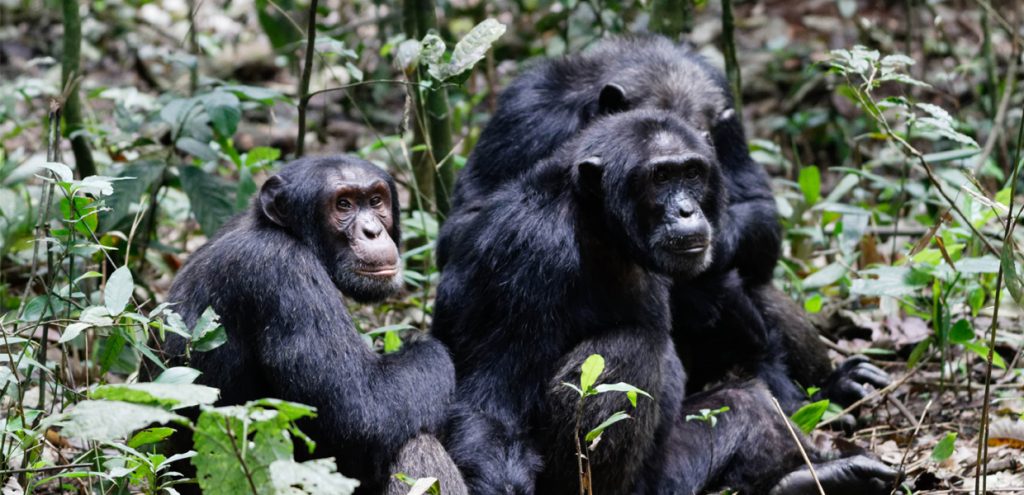
Chimpanzees in Kibale forest, a tropical forest of varying altitudes in wetern Uganda, is home to over 1,500 chimpanzees, the highest concentration in Uganda. It has, as well as the most diverse and densest population of primates in East Africa, more than 13 species in total. These include vervet monkeys, olive baboons and red colobus monkeys, which are also found in these woodlands, making the forest a primate-lover’s dream.
With more than 350 species of birdlife, Kibale National Park will satisfy bird enthusiasts too. The presence of chimpanzees, attribute to the popular chimpanzee trekking safaris done down at Kibale Forest National Park.
About Chimpanzees in Kibale
The average weight of an adult chimpanzee in Kibale, well grown male chimpanzee is between 35 and 70 kilograms, with a height of approximately 3 meters. Whereas an adult female chimpanzee weighs between 26 and 50 kilograms with a height between 2 and 4 feet. When extended, the common chimp’s long arms span one and a half its body’s height.
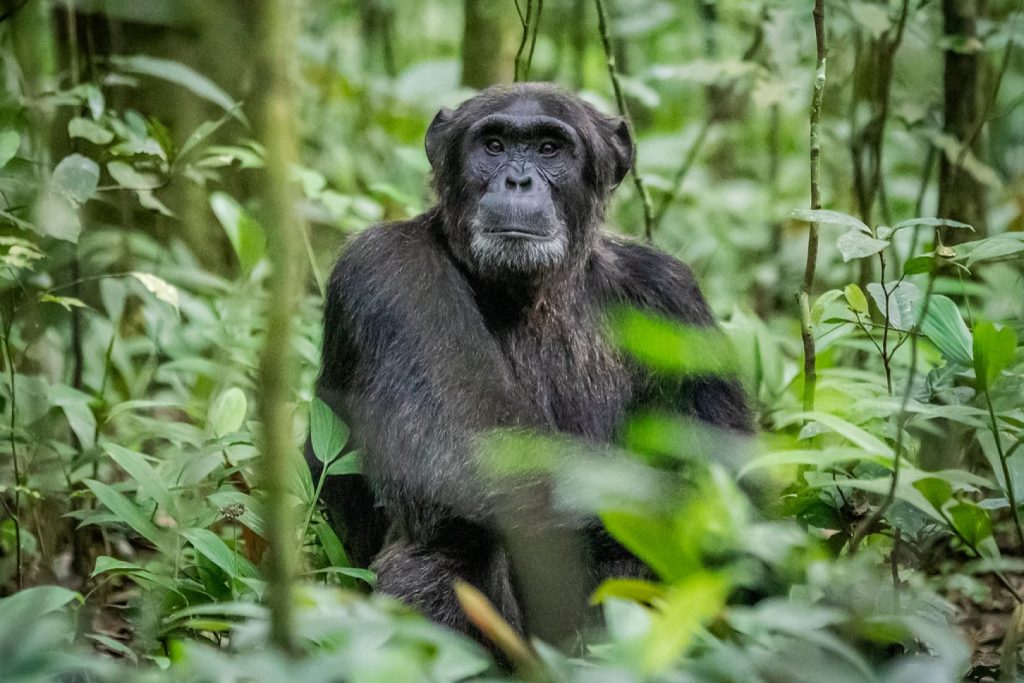
Many chimpanzees in Kibale are tailless; with dark coat. Their face, fingers, palms of the hands and soles of the feet are hairless. The exposed skin of the face, hands, and feet varies from pink to very dark in both species, but is generally lighter in younger individuals and darkens with maturity.
The female chimpanzee bears a single young at any time of year after a gestation period of about eight months. The newborn weighs about 1.8 kg, and like in humans it is almost helpless, always clinging to the fur of the mother’s belly as she moves. From about 6 months to 2 years, the youngster rides on the mother’s back. Weaning takes place at about 5 years.
Males are considered adults at 16 years of age, and females usually begin to reproduce at about 13 years, but often only two offspring survive during her lifetime.
A chimpanzee’s life expectancy is at 50 years whereas those living in captivity can extend up to 60 years. This is due to the good care, clean environment and medical attention given to the chimps while in the captivity which is the not the case while in the wilderness.
Movement of Chimpanzees in Kibale
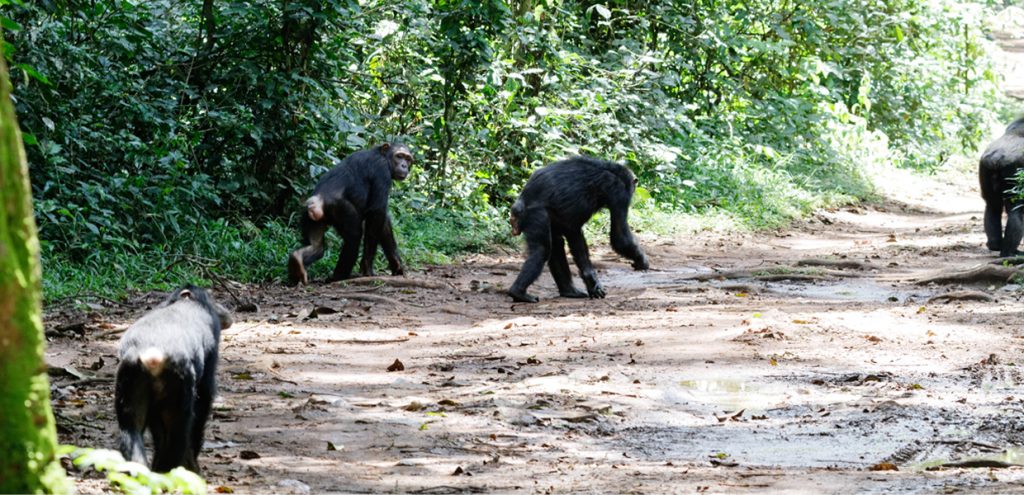
Chimpanzee use their nodes while on movement. The movements of individuals are the foundation of grouping patterns in social groups, therefore it is important to understand the factors that influence movement decisions. The abundance and distribution of food fluctuates seasonally, and chimpanzee movement patterns are expected to adapt to such changes. However, movement patterns may be affected by the reproductive status of the individual or by the presence of estrous females in the community.
Males may exhibit more direct daily paths, as they are more frequently involved in territorial defense than females. There is a relationship between community size and the sinuosity of daily paths. Large parties have an increased number of individuals that could potentially influence movement decisions, which may result in more sinuous movement patterns. Alternatively, the increased foraging competition experienced by large parties may result in direct paths between food patches.
Chimpanzees are better suited for walking than orangutans, because the chimp’s feet have broader soles and shorter toes. The bonobo has proportionately longer upper limbs and walks upright more often than does the common chimpanzee. Both species can walk upright on two legs when carrying objects with their hands and arms.
Conservation of Chimpanzees in Kibale
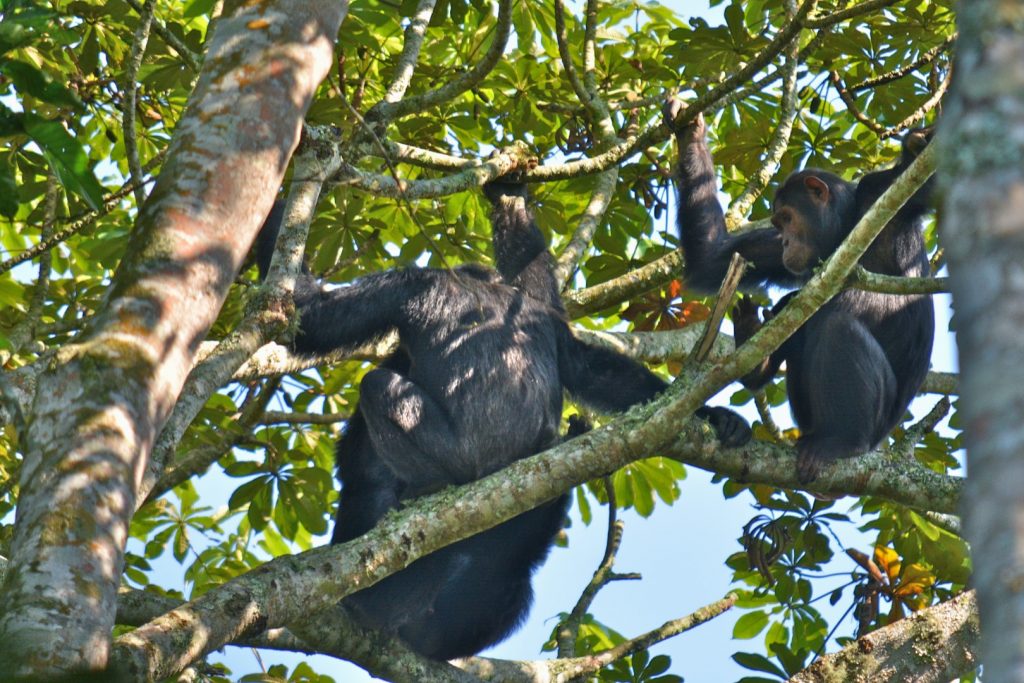
In Uganda today, efforts to actually conserve the chimpanzees are extensively acknowledged and well supported. Actually the Jane Goodall Foundation has played a major role in the overall conservation of not only these chimpanzees but gorillas as well, found in Uganda.
Chimpanzees are the closest relatives to humans sharing about 98.7% of their DNA composition with human beings. They are sociable, intelligent as well as communicative, and among their very fascinating traits is the ability to utilize tools like rocks for crushing nuts, empty pods for hollowing out water plus sticks for capturing termites from their holes. These skills are for long been passed on from generation to another and researchers say that different troops have specialist tasks, basing on their habitat as well as diet.
Chimps stay in groups of 10 – 100 members called communities. They can babysit each other’s young, kiss, groom one another and even hold hands. The young chimps become independent at the age of 4 years. Nonetheless, chimps can be aggressive and unsociable, mostly if disturbed.
Although they spend some time on ground, during hot day hours, they normally feed and do make their sleeping nests up in the trees and can decide to spend the whole day on trees especially when it is wet, having been some kind of rain fall. Their diet varies comprising of leaves, seeds, fruit, flowers and at some time they can hunt for insects and animals like the red colobus monkeys which is their most preferred diet.
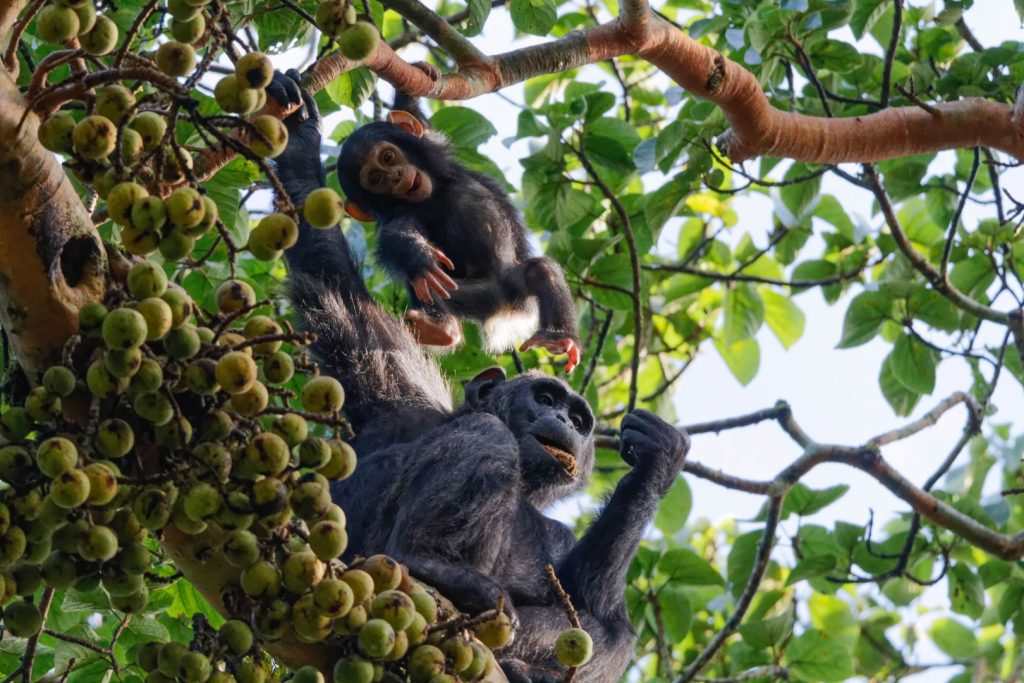
Chimpanzees can use tools as a mean to access some of their resource. Many times chimps have been spotted using sticks to pick ants from and ant hill or use leaves to collect water from the well. Chimpanzees are also known to use smaller stones as hammers and a large one as an anvil in order to break open nuts.
Chimpanzees are known for possessing great amount of muscle strength, especially in their arms. However, compared to humans the amount of strength reported in media and popular science is greatly exaggerated with numbers of four to eight times the muscle strength of a human. This is to reason why your always encourage to keep a distance of 8 meters away from the chimps and this can be observed as they do butter root drumming as a sign of communication which can sound up to 1 km away as they move from one place to another
Social Structure of Chimpanzee
Chimpanzees live in large multi-male and multi-female social groups, which are called communities. Within a community, the position of an individual and the influence the individual has on others dictates a definite social hierarchy. Chimpanzees live in a leaner hierarchy wherein more than one individual may be dominant enough to dominate other members of lower rank.
Typically, a ‘dominant male’ is referred to as the alpha male. The alpha male is the highest-ranking male that controls the group and maintains order during disputes. In chimpanzee society, the dominant male sometimes is not the largest or strongest male but rather the most manipulative and political male that can influence the goings on within a group.
The alpa male in Kibale is called Magezi who happen to lead the entire habituated group who are used for tourism purpose. Male chimpanzees typically attain dominance by cultivating allies who will support that individual during future ambitions for power.
The alpha male regularly displays by puffing his normally slim coat up to increase view size and charge to seem as threatening and as powerful as possible; this behavior serves to intimidate other members and thereby maintain power and authority, and it may be fundamental to the alpha male’s holding on to his status.
Lower-ranking chimpanzees will show respect by submissively gesturing in body language or reaching out their hands while grunting. Female chimpanzees will show deference to the alpha male by presenting their hindquarters.
Female chimpanzees also have a hierarchy, which is influenced by the position of a female individual within a group. In some chimpanzee communities, the young females may inherit high status from a high-ranking mother. Dominant females will also ally to dominate lower-ranking females: whereas males mainly seek dominant status for its associated mating privileges and sometimes violent domination of subordinates, females seek dominant status to acquire resources such as food, as high-ranking females often have first access to them. Both genders acquire dominant status to improve social standing within a group.
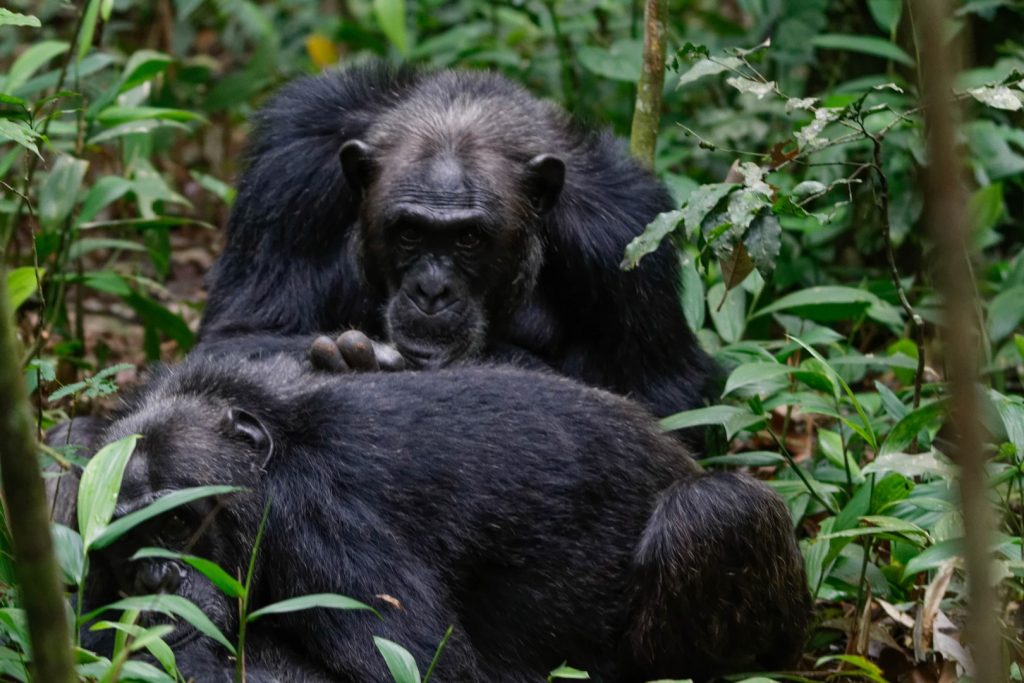
Community female acceptance is necessary for alpha male status; females must ensure that their group visits places that supply them with enough food. A group of dominant females will sometimes oust an alpha male which is not to their preference and back another male, in whom they see potential for leading the group as a successful alpha male.
Nest – Building of Chimpanzees
Nest-building, sometimes considered to be a form of tool used, is seen when chimpanzees construct arboreal night nests by lacing together branches from one or more trees to build a safe, comfortable place to sleep. Infants learn this process by watching their mothers. The nest provides a sort of mattress, which is supported by strong branches for a foundation, and then lined with softer leaves and twigs. The minimum diameter is 5 metres (16 ft) and may be located at a height of 3 to 45 metres (10 to 150 ft).
Both day and night nests are built, and may be located in groups. However nesting is done in places which are seen to be more safe, as a result, chimps often nest near places where there is plenty of food. They can also nest temporary during day time so as to take a nap.
Communication Between Chimpanzees
Chimps communicate in a manner that is similar to that of human nonverbal communication, using vocalizations, hand gestures, and facial expressions. There is even some evidence that they can recreate human speech.
Research into the chimpanzee brain has revealed that when chimpanzees communicate, an area in the brain is activated which is in the same position as the language center called Broca’s area in human brains.
Chimpanzees show their emotions with their faces and sounds. They make hooting sounds to express the discovery of food, and the face of a chimpanzee with a scowling face and lips pressed is to express annoyance. This means the chimpanzee may attack or bare its teeth to express that it is afraid or that a more dominant chimp is approaching
Aggression of Chimpanzees
Adult common chimpanzees, particularly males, can be very aggressive. They are highly territorial and are known to kill other chimps. They always defend their territory and in case nonmembers of the group cross to their territory, they tend to kill, females are always taken over by the strong group that win the fight. However, a female can easily cross to another group. But in case a new baby is born and is not from the male within the group, it’s always killed so as to maintain the group genes.
Hunting
Chimpanzees in Kibale also engage in targeted hunting of lower-order primates, such as the red colobus and bush babies, and use the meat from these kills as a “social tool” within their community.
Puzzle Solving
Chimpanzees in Kibale solve puzzles for entertainment. They always swing from one branch to another or groom as they chase one another.
Laughter in Apes
Laughter might not be confined or unique to humans. The differences between chimpanzee and human laughter may be the result of adaptations that have evolved to enable human speech. Self-awareness of one’s situation as seen in the mirror test, or the ability to identify with another’s predicament are prerequisites for laughter, so animals may be laughing for the same reasons that humans do.
Chimpanzees, gorillas, and orangutans show laughter-like vocalizations in response to physical contact, such as wrestling, play-chasing, or tickling. This is documented in wild and captive chimpanzees. Common chimpanzee laughter is not readily recognizable to humans. as such, because it is generated by alternating inhalations and exhalations that sound more like breathing and panting. Instances in which nonhuman primates have expressed joy have been reported.
One study analyzed and recorded sounds made by human babies and bonobos when tickled. Although the bonobo’s laugh was a higher frequency, the laugh followed a pattern similar to that of human babies and included similar facial expressions. Humans and chimpanzees share similar ticklish areas of the body, such as the armpits and belly. The enjoyment of tickling in chimpanzees does not diminish with age.
Distinctive Habits and Characteristics of Chimpanzees in Kibale
Chimpanzees in Kibale are the most social of all the apes and live in communities of between 15 and 120 individuals. Their communities are often split into a number of subgroups with a male as the leader of the group. Males seldom leave the community where they were born, while females often migrate to a new community during an adolescent estrus period.
Chimpanzees travel mostly on the ground by knuckle walking. They groom each other daily, and this activity has an important social function of calming and comforting individuals and solidifying their bonds with each other. Mothers often travel alone with their offspring.
Chimpanzees in Kibale construct nests at night in which they sleep. Male chimpanzees in the wild cooperatively hunt for meat. Their diet is mainly fruits with regular amounts of insects, as well as birds and small mammals.
Chimpanzees use tools to gain access to food, such as fishing for termites with sticks fashioned for the job and cracking open nuts with anvil-like rocks.
Females in estrus have a prominent swelling of the pink perineal skin that lasts two to three weeks and occurs every four to six weeks. Females give birth every four to five years and their gestation period is eight to nine months.
Chimpanzees in Kibale have a long mother-infant dependency period. Infants will nurse on their mothers for five years and stay with their mothers several more years learning to care for younger siblings.
The life span for chimpanzees is 40 to 50 years in the wild and over 50 to 60 years in captivity.
Life Stages of Chimpanzees in Kibale
Infant: Birth-to-five years (nursed and carried by mother)
Juvenile: Five-to-eight years (still with mother but independent of her for transport and milk)
Early Adolescence: For females, eight-to-ten years and for males, eight-to-12 years
Late Adolescence: For females, 11-to-14 years and for males, 13-to-15 years
Maturity: 16-to-33 years
Old Age: 33 years to death
In Uganda, Chimpanzees can be found in Budongo Forest, that lies in Murchison Falls National Park. We also have Chimpanzees in Kyambura Gorge a section of Queen Elizabeth National Park and others in Kalinzu Forests
